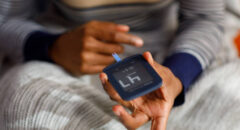
Feel free to open a bottle of your favorite vintage: If you time it right, a little wine might help guard against type 2 diabetes.
A new study suggests that a small glass with dinner may lower the chances of being diagnosed with the blood sugar disease.
Exactly how small? About half an ounce of wine for women and about an ounce of wine for men seems to do the trick, but only when served with a meal, researchers say.
How wine protects against type 2 diabetes
"Drinking moderate amounts of wine with meals may prevent diabetes if your doctor doesn't object to your drinking," says lead researcher Dr. Hao Ma, a biostatistical analyst at Tulane University Obesity Research Center, in New Orleans.
"The majority of previous studies focused on the relationship between amounts of alcohol intake and risk of diabetes. Our findings emphasize the importance of considering the timing of alcohol intake in the association between amounts of alcohol intake and risk of type 2 diabetes," Ma shares.
For the study, Ma's team collected data on over 312,000 drinkers who were included in the UK Biobank. At the start of the study, the participants didn't have diabetes, heart disease or cancer.
During an average of nearly 11 years of follow-up, about 8,600 participants developed type 2 diabetes. Those who drank alcohol with meals had a 14% lower risk of developing type 2 diabetes, compared with those who drank without eating, the researchers found.
The biggest benefit was seen among those who drank wine with meals and not other alcoholic drinks. Drinking wine was tied with a lower risk of type 2 diabetes, but drinking beer or liquor was linked with a higher risk of type 2 diabetes, the findings showed.
RELATED: Drink More Wine! 10 Ways Red Wine Makes You Healthier
Is wine healthy for you?
The American Heart Association and the U.S. Centers for Disease Control and Prevention recommend that adults who don't drink shouldn't start. People who drink regularly should talk with their doctors about the benefits and risks of alcohol.
The key to healthful drinking is moderation, defined as one glass of wine or other alcoholic drink daily for women and up to two glasses for men.
Diabetes specialist Dr. Joel Zonszein, an emeritus professor of medicine at Albert Einstein College of Medicine in New York City, says, "Wine cannot be bad; it has been part of dietary consumption for more than 6,000 to 7,000 years."
But alcohol has both good and bad health effects, he explains.
"Red wine, as part of a healthy diet, is safe and decreases cardiometabolic risk. It is rich in antioxidants, improves the good cholesterol, keeps the heart healthy and even improves sugar metabolism," Zonszein shares.
"In my many years of practice, I never asked patients to stop drinking. In fact, many were thankful when I mentioned that it is recommended and the potential benefits," he adds. "Of course in whom, how much alcohol, what type of alcoholic beverage, and when to drink it is important. Drinking alcohol needs to be individualized, and the potential risk and benefits need to be discussed with each patient. I welcome the study supporting that a glass of wine with meals, already used by so many, can prevent type 2 diabetes."
Stop It Before It Starts: Eliminating Prediabetes and Reversing Type 2 Diabetes
Preventing type 2 diabetes
It is proven that type 2 diabetes can be prevented or delayed with the following lifestyle changes:
1. Lose weight
One study shows that people reduced their risk of developing diabetes by almost 60% after losing approximately 7% of their body weight due to changes in exercise and diet.
The American Diabetes Association recommends losing at least 7% to 10% of your bodyweight if you have prediabetes. This will prevent disease progression.
Start by setting a weight-loss goal that is based on your current body weight. You can also talk to your doctor about short-term goals and expectations that are reasonable, such as losing 1 to 2 pounds a week.
2. Be more physically active
Exercise can help you:
- Lose weight
- Lower your blood sugar
- Boost your sensitivity to insulin — which helps keep your blood sugar within a normal range
Aim for 30 minutes or more of moderate to vigorous exercise a few times a week.
3. Eat healthy plant foods
Fiber-rich foods not only promote weight loss, but they also lower the risk of diabetes. Try eating a variety of healthy, fiber-rich foods, which include:
- Fruits, such as tomatoes, peppers and fruit from trees
- Nonstarchy vegetables, such as leafy greens, broccoli and cauliflower
- Legumes, such as beans, chickpeas and lentils
- Whole grains, such as whole-wheat pasta and bread, whole-grain rice, whole oats, and quinoa
Remember to avoid foods that are "bad carbohydrates." These foods are high in sugar and have little fiber or nutrients. This includes white bread and pastries, pasta from white flour, fruit juices, and processed foods with sugar or high-fructose corn syrup.
4. Eat healthy fats
While fatty foods can be high in calories, unsaturated fats ("good fats") promote healthy blood cholesterol levels and good heart and vascular health.
These fats can be found in:
- Olive, sunflower, safflower, cottonseed and canola oils
- Nuts and seeds, such as almonds, peanuts, flaxseed and pumpkin seeds
- Fatty fish, such as salmon, mackerel, sardines, tuna and cod
Saturated fats ("bad fats") that are found in dairy products and meats should only be a small part of your diet. Limit these fats by eating low-fat dairy products and lean chicken and pork.
5. Skip fad diets and make healthier choices
There is little research on the long-term benefits of fad diets or their role in preventing diabetes.
If you are trying to eat healthy, remember this:
- One-half: fruit and nonstarchy vegetables
- One-quarter: whole grains
- One-quarter: protein-rich foods, such as legumes, fish or lean meats
As always, remember to share your concerns about diabetes prevention with your doctor, he or she can offer more tips or suggestions on lowering your risk based on your medical history.









